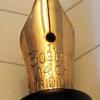Search the Community
Showing results for tags 'capillary force'.
-

Pens That Change From Bone Dry To Very Wet
TheDutchGuy posted a topic in Fountain & Dip Pens - First Stop
In this discussion, I noted that a lot of my newly bought pens started out bone dry but became wet (or even very very wet) later on. Initial flushing and cleaning to clear out oils and residues didn't help. Using very wet inks didn't help, or only a little bit. I think this phenomenon may be relevant because quite a few people complain of certain pens being (too) dry. Kaweco is a brand that is often mentioned in this context and sure enough my two Kawecos were initially very dry. So was my Visconti van Gogh, that one was unusable. Over time, these pens very gradually became wet and the Visconti became very wet. I'm now sort of moving towards dryer inks with these pens! The conclusion is that (for example) Kaweco pens are not dry pens, but that many of them start their life as a dry pen. Why? Many people start tinkering with nibs to make new pens wetter. Is this needed? I think (emphasis on: think) the answer lies in materials science. The nib is new and has not been exposed to ink yet. The feed is new. The converter is new. Flushing and cleaning may help a bit, but it didn't help me much with these pens. There's a lot of surface area in a feed. My hypothesis is, that over time, with use, the surface tension characteristics of the converter, the feed and the nib change. This then gradually leads to a wetter pen. This hypothesis is supported somewhat by my observation in multiple pens that a small drop of glycerine speeds up this process; immediately the pen becomes wetter, and after one or two fills with glycerine-enriched ink the pen it stays wetter (search FPN for glycerine; much has been said about it; it's completely different stuff than photoflow). My personal view is, that wetness can only be objectively determined in a well-used pen. Saying that a new pen is dry is like saying that a freshly picked green banana is hard. The banana takes time to ripen. A pen takes a lot of use to show its true character. It might be different with top-quality pens like an M1000 or a 149 or something similar. I didn't notice it with my new Sailor pens, for example. But with entry-level or intermediate-level pens, I've noticed this too many times for it to be a coincidence. In reverse, a new pen that is very very wet might become too wet later on. Something to watch out for. My approach now is: if I like a new pen in every aspect except dryness, I thoroughly flush it, clean it and then add a little bit of glycerine to the first two fills. Then I do a fill without glycerine. This seems to do the trick. Anyway, just my 2 cts. (Obviously we might criticize the manufacturer for such temporary dryness, but there's probably not much point in doing so.)- 11 replies
-
- wetness
- capillary force
-
(and 1 more)
Tagged with:
